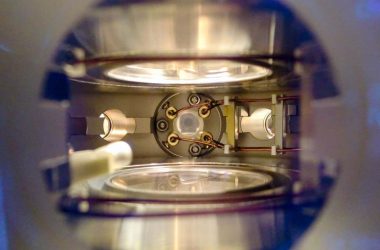Fermilab’s Muon g-2 experiment is adding to evidence that the standard model is incomplete
Ryan Postel/Fermilab
The standard model of particle physics is starting to show signs of weakness. The behavior of a fundamental particle called the muon has deviated from what is predicted by the standard model, according to new experimental results from Fermilab in Illinois. This deviation suggests the existence of unknown forces and particles beyond our current understanding.
What’s unusual about the muons’ behavior? The discrepancies were observed in the spin rate of muons when exposed to a magnetic field. This spin rate, represented by the g-factor, is influenced by the interactions between muons and other particles. According to the standard model, which accounts for all known particles and forces, the g-factor should be precisely 2. However, measurements taken since 2006 have consistently shown that muons rotate slightly faster than expected, resulting in a g-factor of 2.002.
How is the g-factor measured? The g-factor of muons is determined by measuring their spin using a phenomenon called precession, where the particle wobbles as it spins. At Fermilab, muons are accelerated around a magnetic storage ring at almost the speed of light. During their journey, they interact with virtual particles that appear and disappear due to quantum effects. Physicists analyze the precession rates of the muons using a “wiggle plot” to calculate their g-factors.
How do the new measurements differ from previous ones? The recent measurements at Fermilab are more precise than any previous measurements, with a precision of 0.2 in a million. This is twice as precise as Fermilab’s previous measurements announced in 2021. Importantly, these new measurements have reached a statistical confidence level of 5 sigma, meaning there is only a 1 in 3.5 million chance that the observed data is a statistical fluke if the standard model is correct. In particle physics, a 5-sigma measurement is considered a significant discovery rather than just a hint.
How was this precision achieved? The increased precision is attributed to analyzing a larger amount of data compared to previous measurements. While the 2021 measurements only had data from 2018, the new research incorporated data from 2019 and 2020, more than quadrupling the number of observed muons. The experimental protocol was also improved, including stabilizing the muon beam and better characterizing the magnetic field used to induce the muons’ spin. The researchers are now planning to include data from 2021 to 2023 in a final, highly precise report on the muons’ g-factor, which is expected to be published in 2025.
What does this mean for particle physics? The broader implications of these measurements are still unknown, especially as theoretical efforts to understand the muons’ g-factors are ongoing. However, if the observed discrepancies persist in future calculations, it suggests that the standard model might be missing some type of particle. This hypothetical particle could manifest as a virtual particle, interacting with muons through an undiscovered force before disappearing again. Nevertheless, further precise measurements are necessary to provide more insights into the existence of such a particle, if it exists.
Topics:












